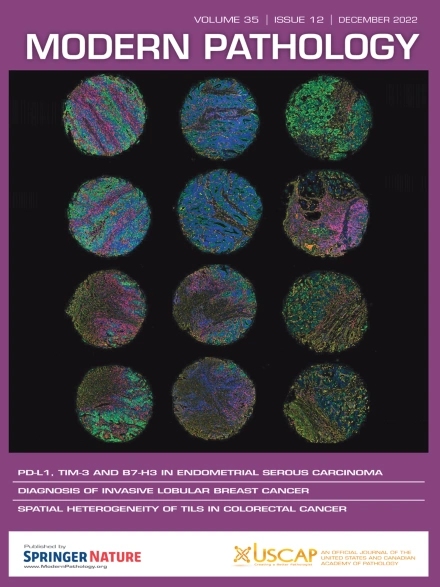揭开 UTROSCT 分子图谱:对 35 例病例进行临床病理学、形态学、免疫组化和分子分析的启示。
IF 7.1
1区 医学
Q1 PATHOLOGY
引用次数: 0
摘要
类似卵巢性索肿瘤的子宫肿瘤(UTROSCT)是一种血统不确定、恶性程度低的罕见肿瘤。大多数肿瘤表现为良性,但也有一部分 UTROSCT 表现出侵袭性的临床过程,会出现复发和转移。UTROSCT 中反复出现的分子改变大多是涉及 NCOA1-3 的基因融合。我们对 35 例 UTROSCT 进行了全面的临床病理学、形态学、免疫组化和分子分析。这些肿瘤表现出不同的结构模式(弥漫型、条索状/十八形、管状、绒毛状、束状、轮状、巢状、微叶状和假腺状),而且往往是混合型。免疫组化分析证实了多型性免疫特征,性索间质、平滑肌和上皮标记物以及激素受体往往同时表达。NGS RNA分析显示,在22/32个分析病例(69%)中存在复发性NCOA1-3基因融合,包括ESR1::NCOA3(11/22)、GREB1::NCOA2(7/22)、ESR1::NCOA2(3/22)和GREB1::NCOA1(1/22)。所有病例的肿瘤突变负荷都很低。融合阳性病例在统计学上与轮状结构有显著关联,相反,坏死则与融合阴性状态有关。我们没有发现任何结构模式与GREB1-改变之间有明显的关系,但NCOA2-改变的肿瘤与假腺结构有关。与 ESR1 基因改变的病例相比,GREB1 基因改变的病例多发生在年龄较大的患者中,而且往往是壁内肿块。相反,ESR1改变的病例更多表现为粘膜下或息肉状肿瘤。有两个肿瘤表现出侵袭性和复发性。这两个病例都存在GREB1::NCOA2融合。对我们的队列进行的无监督分层聚类分析发现了两个主要聚类。GREB1或NCOA2融合的肿瘤聚集在一起,表明这些病例与ESR1::NCOA3融合或无融合的病例之间存在潜在的分子差异。我们的研究结果有助于进一步了解这种目前生物学行为尚不确定的罕见肿瘤。本文章由计算机程序翻译,如有差异,请以英文原文为准。
Unraveling the Molecular Landscape of Uterine Tumor Resembling Ovarian Sex Cord Tumor: Insights From A Clinicopathological, Morphologic, Immunohistochemical, and Molecular Analysis of 35 Cases
Uterine tumor resembling ovarian sex cord tumor (UTROSCT) is a rare tumor of uncertain lineage and low malignant potential. Most tumors behave in a benign manner, but a subset of UTROSCT exhibit an aggressive clinical course with recurrences and metastases. The recurrent molecular alterations in UTROSCT mostly represent gene fusions involving NCOA1-3. We performed a comprehensive clinicopathological, morphologic, immunohistochemical, and molecular analysis on a cohort of 35 UTROSCT. The tumors exhibited various architectural patterns (diffuse, corded/trabecular, tubular, sertoliform, fascicular, whorled, nested, microfollicular, and pseudoglandular), often in combination. The immunohistochemical analysis confirmed the polyphenotypic immunoprofile, often with coexpression of sex cord–stromal, smooth muscle, and epithelial markers, as well as hormone receptors. Next-generation sequencing RNA analysis revealed recurrent NCOA1-3 gene fusions in 22/32 analyzed cases (69%), including ESR1::NCOA3 (11/22), GREB1::NCOA2 (7/22), ESR1::NCOA2 (3/22), and GREB1::NCOA1 (1/22). Tumor mutation burden was low in all cases. The fusion-positive cases exhibited statistically significant association with whorled architecture, conversely necrosis was associated with fusion-negative status. We did not find a significant relationship between any architectural pattern and GREB1 alterations, but the NCOA2-altered tumors were associated with pseudoglandular architecture. The GREB1-altered cases occurred in older patients and tended to be more often intramural masses compared with ESR1-altered cases. On the contrary, the ESR1-altered cases presented more often like submucosal or polypoid tumors. Two tumors exhibited aggressive behavior with recurrent disease. Both of these cases harbored a GREB1::NCOA2 fusion. Unsupervised hierarchical cluster analysis of our cohort revealed 2 main clusters. The tumors with GREB1 or NCOA2 fusion cluster together, suggesting that there are underlying molecular differences between these cases and cases with ESR1::NCOA3 fusion or without fusion. Our findings contribute to the growing knowledge about a rare neoplasm with currently uncertain biological behavior.
求助全文
通过发布文献求助,成功后即可免费获取论文全文。
去求助
来源期刊

Modern Pathology
医学-病理学
CiteScore
14.30
自引率
2.70%
发文量
174
审稿时长
18 days
期刊介绍:
Modern Pathology, an international journal under the ownership of The United States & Canadian Academy of Pathology (USCAP), serves as an authoritative platform for publishing top-tier clinical and translational research studies in pathology.
Original manuscripts are the primary focus of Modern Pathology, complemented by impactful editorials, reviews, and practice guidelines covering all facets of precision diagnostics in human pathology. The journal's scope includes advancements in molecular diagnostics and genomic classifications of diseases, breakthroughs in immune-oncology, computational science, applied bioinformatics, and digital pathology.
 求助内容:
求助内容: 应助结果提醒方式:
应助结果提醒方式:


